Predicting ecological change in tussock grasslands of Aotearoa New Zealand
IF 1.4
3区 环境科学与生态学
Q3 ECOLOGY
引用次数: 0
Abstract
: Natural grasslands are among the most threatened biomes on Earth. They are under pressure from land cover change including afforestation, farming intensification, invasive species, altered fire regimes, and soil amendments, all of which impact native biodiversity and ecosystem functioning. In Aotearoa New Zealand, tussock-dominated native grasslands expanded due to increased fire activity during waves of human settlement. These areas have subsequently been maintained as modified grasslands by agricultural pastoral land management practices and effects of introduced feral mammals. Despite many decades of research on biodiversity in tussock grasslands, we need greater fundamental understanding of many processes causing change in their biodiversity and ecosystem functioning in order to predict how future global change will impact this important and increasingly threatened biome. In this perspective forum article, we present five key research questions that, if answered, would greatly enhance our understanding of connections between tussock grassland biodiversity, ecosystem functioning, and associated ecosystem services: (1) What are the relative impacts of domesticated and non-domesticated mammals on indigenous biodiversity in grasslands? (2) Where will invasive plants undergo range expansion? (3) Will future fires tip tussock grasslands into alternative vegetation states? (4) What are the implications of woody thickening by native or non-native species? (5) What are the impacts of global change, and vegetation change in particular, on soil processes and ecosystem functioning? We provide recommendations for research to address and integrate across these questions using both existing and new data. This work would build on our current knowledge and lead to a framework to better understand the ecological impacts of ongoing global change in tussock grasslands.预测新西兰奥特罗阿草原的生态变化
本文章由计算机程序翻译,如有差异,请以英文原文为准。
求助全文
约1分钟内获得全文
求助全文
来源期刊

New Zealand Journal of Ecology
环境科学-生态学
CiteScore
3.00
自引率
12.50%
发文量
35
审稿时长
>36 weeks
期刊介绍:
The New Zealand Journal of Ecology is a biannual peer-reviewed journal publishing ecological research relevant to New Zealand/Aotearoa and the South Pacific. It has been published since 1952 (as a 1952 issue of New Zealand Science Review and as the Proceedings of the New Zealand Ecological Society until 1977). The Journal is published by the New Zealand Ecological Society (Inc.), and is covered by Current Contents/Agriculture, Biology and Environmental Science, GEOBASE, and Geo Abstracts.
 求助内容:
求助内容: 应助结果提醒方式:
应助结果提醒方式:


